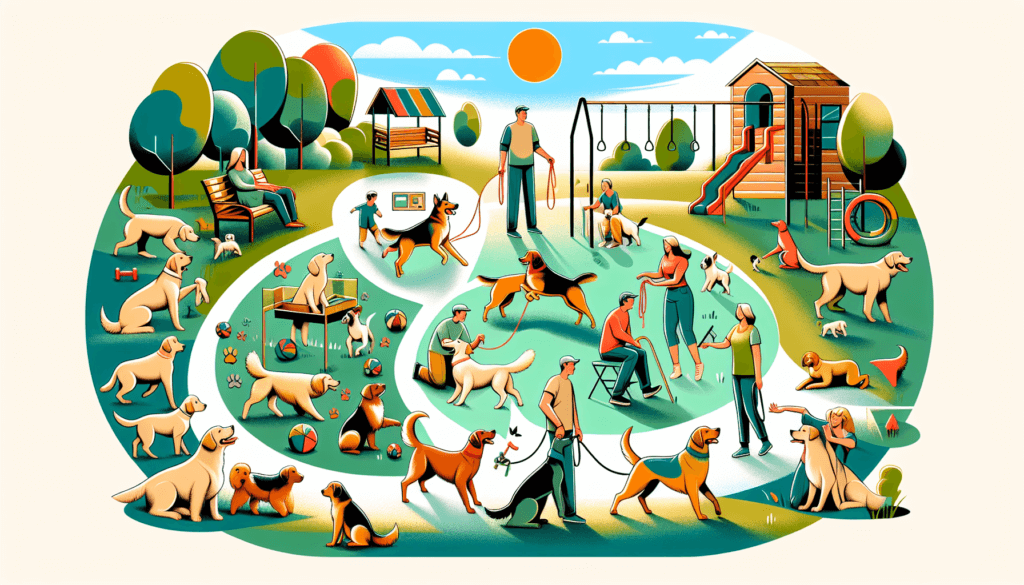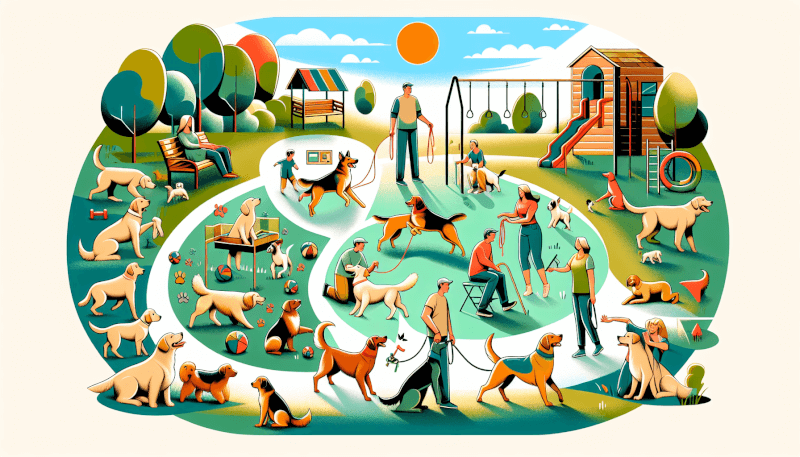Imagine a community where dogs and their owners gather not only to play, but also to learn and grow together. In this unique setting, dogs receive more than just basic obedience training; they are provided with a comprehensive education that enriches their lives and strengthens the bond between them and their owners. By incorporating training and education into a dog community, not only do dogs become better behaved and more well-rounded, but owners also gain valuable skills and knowledge that make their lives with their furry companions more enjoyable and fulfilling. This article explores the numerous benefits of incorporating training and education in a dog community, highlighting the positive impact it has on both dogs and their loving owners.

Improves Behavior and Socialization
Reduces aggression and fear
Training and education programs within a dog community can have significant positive impacts on a dog’s behavior and socialization skills. By providing structured training, dogs can learn how to manage their aggression and fear in various situations. Through proper guidance and exposure, dogs can become more confident and less reactive towards other dogs, animals, and humans. This reduction in aggression and fear not only creates a safer environment for the community but also improves the overall welfare of the dogs involved.
Enhances communication skills
Effective communication is key to building strong relationships, and this applies to the bond between dogs and their owners as well. Through training and education, owners can learn how to understand their dogs’ body language, vocalizations, and subtle cues, enabling them to respond appropriately. Similarly, dogs can learn to interpret and respond to their owners’ commands and signals. By enhancing communication skills, both can better express their needs and desires, leading to more fulfilling and harmonious interactions.
Boosts confidence and trust
Training and education programs help boost the confidence of both dogs and their owners. As dogs learn new skills and master various tasks, they gain a sense of accomplishment and self-assurance. This increase in confidence translates into a more positive and trusting relationship between the dog and its owner. Moreover, training exercises that involve teamwork and cooperation foster a deep bond of trust, ensuring that the dog feels secure in its handler’s guidance and leadership.
Promotes positive interactions
In a dog community, training and education contribute to promoting positive interactions among dogs and their owners. Well-socialized dogs are more likely to engage in friendly play and effectively navigate social situations. Through group training sessions and socialization exercises, dogs can become comfortable and confident when meeting new dogs and people. This creates a supportive and friendly atmosphere within the community, where dogs can interact in a positive and respectful manner.
Promotes Mental Stimulation
Prevents boredom and destructive behavior
Just like humans, dogs need mental stimulation to keep their minds active and engaged. Without it, they may become bored and resort to destructive behaviors, such as excessive chewing or digging. Training and education provide dogs with mental challenges, such as learning new commands, solving puzzles, or participating in agility courses. These activities keep dogs mentally stimulated, preventing boredom and the resulting destructive behaviors.
Enhances problem-solving skills
Training and education programs offer dogs the opportunity to develop and enhance their problem-solving skills. Through tasks like obedience training, obstacle courses, and puzzle toys, dogs learn to assess situations, identify solutions, and adapt their behaviors accordingly. This cognitive stimulation not only exercises their problem-solving abilities but also encourages independent thinking and boosts their overall intelligence and ability to navigate the world.
Fosters learning and growth
In a dog community that prioritizes training and education, both dogs and their owners have endless opportunities for learning and growth. Through classes, workshops, and seminars, owners can expand their knowledge of dog behavior, training techniques, and responsible pet ownership. As owners continue to educate themselves, they can effectively apply new knowledge to their training methods, resulting in continuous growth for both themselves and their dogs.

Strengthens the Bond between Dogs and Owners
Builds a foundation of trust and respect
Training and education play a vital role in building a strong foundation of trust and respect between dogs and their owners. Through consistent and positive training methods, owners establish themselves as trustworthy leaders and providers. Dogs, in turn, learn to rely on their owners for guidance and support. This mutual trust and respect form the basis of a healthy and enriching bond between dogs and their owners.
Creates a sense of teamwork
Training and education often involve various activities that require teamwork between dogs and their owners. From obedience training to agility courses, these exercises encourage collaboration and cooperation. Working together towards achieving common goals fosters a sense of teamwork between dogs and their owners. This shared experience strengthens their connection and deepens their bond, promoting a harmonious and fulfilling relationship.
Enhances understanding and empathy
Through training and education, owners gain a better understanding of their dogs’ needs, emotions, and behaviors. This understanding allows them to empathize with their dogs and respond appropriately to their desires and concerns. As owners demonstrate empathy and compassion, dogs feel understood and valued, which further strengthens the bond between them. This enhanced understanding and empathy help create a nurturing and supportive environment within the dog community.
Increases Safety for Dogs and the Community
Prevents accidents and injuries
Training and education programs significantly contribute to the safety of both dogs and the community at large. Well-trained dogs are less likely to engage in dangerous behaviors, such as running into traffic, chasing wildlife, or becoming overly aggressive towards people or other animals. By teaching dogs to respond reliably to commands and exhibiting good leash manners, owners can prevent potentially harmful situations, reducing the risk of accidents and injuries.
Teaches dogs to follow commands
A fundamental aspect of training and education is teaching dogs to follow commands. Dogs who respond promptly and consistently to commands are easier to manage in various settings. Whether it’s recalling a dog from a potentially dangerous situation or asking them to sit and wait at a crosswalk, obedient dogs are less likely to engage in risky behaviors. This adherence to commands increases safety for both dogs and the community by minimizing potential hazards and conflicts.
Improves leash manners and recall
Training and education programs focus on teaching dogs proper leash manners, including walking calmly on a leash, not pulling, and not reacting negatively to distractions. Dogs who exhibit good leash manners are easier to control and less likely to pose a threat to themselves or others. Additionally, training dogs on recall commands ensures that they can be safely brought back to their owners when off-leash. These skills promote safety and allow dogs to enjoy the freedom of exploring their surroundings responsibly.

Provides Physical Exercise
Promotes overall health and fitness
Regular physical exercise is crucial for a dog’s overall health and fitness. Training and education programs often incorporate physical activities, such as obedience training, agility exercises, and interactive games. These activities provide dogs with the necessary physical exercise to maintain a healthy weight, strengthen muscles, and improve cardiovascular health. A physically fit dog is more likely to lead a long and healthy life.
Reduces obesity and related health issues
Lack of exercise can lead to obesity in dogs, which in turn increases the risk of various health issues, including joint problems, heart disease, and diabetes. Training and education programs that emphasize physical activity help combat obesity by providing dogs with the necessary exercise to burn calories and maintain a healthy weight. Regular exercise not only reduces the risk of obesity but also improves overall health and well-being.
Prevents behavioral issues caused by lack of exercise
Dogs who don’t receive adequate physical exercise are more likely to develop behavioral issues, such as hyperactivity, excessive barking, and destructive behavior. Training and education programs that incorporate physical activities provide an outlet for dogs to release their energy in a controlled and appropriate manner. By engaging in regular exercise, dogs are less likely to exhibit behavioral issues caused by pent-up energy, leading to a calmer and more well-adjusted dog.
Promotes Responsible Dog Ownership
Teaches proper care and handling
Training and education programs play a vital role in teaching dog owners the proper care and handling of their pets. Through workshops and classes, owners learn about nutrition, grooming, veterinary care, and basic canine first aid. Understanding these essential aspects of responsible dog ownership ensures that dogs receive the care they need, promoting their overall health and well-being.
Encourages adherence to laws and regulations
Training and education programs inform dog owners about relevant laws and regulations related to dog ownership. Owners learn about leash laws, licensing requirements, and responsible waste management. By educating owners about these legal obligations, training and education programs promote responsible ownership and help maintain a safe and orderly community for both dogs and their owners.
Reduces the risk of unwanted behaviors
Well-trained and properly educated dogs are less likely to engage in unwanted behaviors that may pose risks to themselves, other animals, or the community. By teaching dogs appropriate behaviors and providing owners with the tools and knowledge to address behavioral issues effectively, training and education programs significantly reduce the risk of unwanted behaviors. This promotes a harmonious community where dogs and their owners can coexist peacefully.

Creates a Supportive and Knowledgeable Community
Connects dog owners with similar interests
Training and education programs within a dog community create opportunities for dog owners to connect with others who share similar interests and love for dogs. These programs often involve group classes, workshops, and socialization events, providing a platform for dog owners to come together and interact. Bonding over a common passion allows owners to form friendships, share experiences, and support one another.
Encourages information sharing and problem-solving
In a supportive dog community, training and education programs foster an environment of information sharing and problem-solving. Owners can exchange knowledge, tips, and advice with one another, helping to address common challenges and overcome obstacles. This collaborative approach creates a network of support where dog owners can learn from each other’s experiences and find solutions for their training and dog-related concerns.
Provides access to resources and professional advice
Training and education programs often provide access to valuable resources and professional advice. Experienced trainers and behaviorists can offer guidance and support, helping owners navigate specific training issues or behavioral concerns. Additionally, training programs may offer access to libraries, online forums, and educational materials, providing a wealth of information for owners to further their understanding of dog behavior and training techniques.
Enhances Training Methods and Techniques
Keeps up with current research and best practices
The field of dog training and behavior is continually evolving, with new research and best practices emerging over time. Training and education programs ensure that dog owners stay up to date with the latest advancements in training methods and techniques. By incorporating evidence-based approaches and following best practices, owners can optimize their training efforts and ensure the overall well-being and success of their dogs.
Introduces innovative training approaches
In a dog community that values training and education, innovative training approaches are often introduced and shared. These approaches may utilize technology, such as virtual reality or interactive training platforms, to enhance the learning experience for dogs and owners. By embracing new and innovative training methods, the dog community can continuously explore novel ways to effectively train and develop dogs’ skills and behaviors.
Promotes positive reinforcement and force-free training
Positive reinforcement and force-free training techniques have proven to be highly effective and humane ways of training dogs. Training and education programs advocate for these methods, promoting the use of rewards, praise, and encouragement to reinforce desired behaviors. By emphasizing positive reinforcement and discouraging the use of aversive methods, the dog community fosters a culture of compassion and respect towards dogs, facilitating their overall well-being and happiness.

Facilitates Therapy and Service Dog Training
Prepares dogs for assisting individuals with disabilities
Training and education programs within a dog community are instrumental in preparing dogs for service and therapy work. These programs focus on teaching dogs the specific tasks and behaviors required to assist individuals with disabilities, such as guiding the blind or alerting to seizures. Through specialized training, dogs develop the necessary skills to support and enhance the quality of life for those in need.
Supports therapy and emotional support dog programs
Therapy and emotional support dogs provide immense comfort and therapeutic benefits to individuals facing physical, emotional, or psychological challenges. Training and education programs play a crucial role in preparing and certifying dogs for these roles. By providing comprehensive training and education, the dog community supports therapy and emotional support dog programs, ensuring that these valuable resources are available to those who can benefit from them.
Promotes inclusivity and accessibility
By incorporating training and education programs for therapy and service dog training, the dog community promotes inclusivity and accessibility for individuals with disabilities. These programs create opportunities for individuals to acquire, train, and partner with service dogs, thereby empowering them to live more independent and fulfilling lives. The dog community’s commitment to inclusivity ensures that everyone, regardless of their abilities, has equal access to the benefits of a well-trained and skilled service dog.
Creates Opportunities for Career Development
Provides avenues for professional dog training
Training and education programs within a dog community offer avenues for individuals interested in pursuing a career in dog training. These programs provide comprehensive training and certification opportunities, equipping individuals with the knowledge and skills necessary to become professional dog trainers. By fostering the growth and development of aspiring trainers, the dog community contributes to the professionalization of the dog training industry.
Supports dog-related businesses and services
Training and education programs contribute to the success and growth of dog-related businesses and services within a community. By creating a demand for quality training and education, these programs support local businesses, such as training schools, pet supply stores, and grooming centers. This support stimulates economic growth and enriches the dog community by providing a variety of quality services and resources.
Fosters growth in the pet industry
A thriving dog community with strong training and education programs contributes to the overall growth of the pet industry. As more individuals become knowledgeable about dogs’ needs, training techniques, and responsible ownership, the demand for pet-related products and services increases. This growth in the pet industry opens up opportunities for various enterprises, such as pet food manufacturers, toy designers, and pet health practitioners, creating a vibrant and dynamic industry.


